| Pages:
1
..
16
17
18 |
Nemo_Tenetur
Harmless

Posts: 28
Registered: 13-12-2023
Location: Germany
Member Is Offline
|
|
The total weight of the (almost) dry product is about 1,28 gram, that´s pretty close to the theoretical maximum 1,33 gram.
See attached pictures, 760 milligram with one eurocent-coin (16,25 mm diameter, for a rough estimation of bulk density) and 520 milligram without.
I guess the bulk density is not as good as expected (patent claimed about 1,5 gram per milliliter), but I do not want to measure it out.
The flowability is moderate, maybe it´s not completely dry.
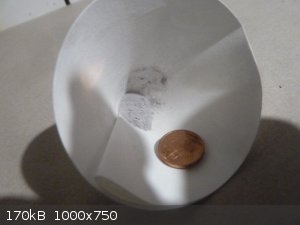 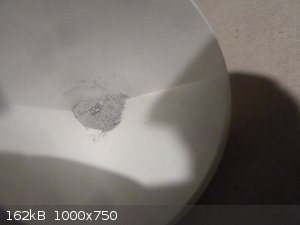
|
|
|
Nemo_Tenetur
Harmless

Posts: 28
Registered: 13-12-2023
Location: Germany
Member Is Offline
|
|
Silver azide flowability
Anyone here with Silver azide experience? I´d like to get comments about the flowability of my sample since this is the first preparation I´ve
performed.
I´m not sure if it is perfectly dry and I´ll store the sample at slightly elevated temperature for one or two additional days and repeat the test.
Sample weight is about 680 milligram.
Attachment: Silver azide flowability.mp4 (1.4MB)
This file has been downloaded 72 times
|
|
|
Etanol
Hazard to Others
  
Posts: 136
Registered: 27-2-2012
Member Is Offline
Mood: No Mood
|
|
Quote: Originally posted by Nemo_Tenetur  |
I guess the bulk density is not as good as expected (patent claimed about 1,5 gram per milliliter), but I do not want to measure it out.
|
The bulk density depends on the form of the crystals. If it is low, you probably violated something in technology. Look at your product in a
microscope.
|
|
|
Nemo_Tenetur
Harmless

Posts: 28
Registered: 13-12-2023
Location: Germany
Member Is Offline
|
|
Poor ignitability
The silver azide sample prepared by the improved costain process is now completely dry, but the ignitability is poor. I think something went wrong
with my first batch.
More than two seconds exposure to a blue gas flame are required to get the bang, only faint crackling (maybe microgram quantities blown away from the
gas stream?) prior the final bang (which was quite powerful).
Attachment: Silver azide delay.mp4 (449kB)
This file has been downloaded 60 times
Attachment: Silver azide delay slow-motion.mp4 (574kB)
This file has been downloaded 63 times
[Edited on 8-2-2024 by Nemo_Tenetur]
|
|
|
Microtek
National Hazard
   
Posts: 828
Registered: 23-9-2002
Member Is Offline
Mood: No Mood
|
|
You should prepare a sample of AgN3 by the regular process (AgNO3 and NaN3 solutions, dropwise addition of one to the other) to compare. I think this
"improved" process seems unecessarily complex, and I question the need for silver azide with better processability (unless you are preparing very
large amounts of detonators).
|
|
|
Etanol
Hazard to Others
  
Posts: 136
Registered: 27-2-2012
Member Is Offline
Mood: No Mood
|
|
The heat resistance of AgN3 causes unexpected effects sometimes. When you bring a burning match, it first often melts total and then explodes very
powerful.
Try to explode it with hot NiCr wire.
Are you sure your reagents are free from impurities of Cl- and SO4(--)?
Try to use more diluted solutions for synthesis. This will reduce the content of soluble impurities in the product.
Quote: Originally posted by Microtek  | | You should prepare a sample of AgN3 by the regular process (AgNO3 and NaN3 solutions, dropwise addition of one to the other) to compare. I think this
"improved" process seems unecessarily complex, and I question the need for silver azide with better processability (unless you are preparing very
large amounts of detonators). |
No, ammonia does not form stable complexes with AgN3 in solid form. At least the power of the product does not decrease after recrystallization from
water ammonia compared to PbN6.
[Edited on 9-2-2024 by Etanol]
|
|
|
Nemo_Tenetur
Harmless

Posts: 28
Registered: 13-12-2023
Location: Germany
Member Is Offline
|
|
Second batch seems better
Thank you for fast reply. I´ve performed a second batch with same quantity of reagents, but - as suggested - more diluted with distilled water.
I´ve also reduced the reaction temperature from 75 degree centigrade to 55 - 60 degree and a prolonged reaction time (6 hours followed by a very slow
cool-down over night).
My first impression is positive, a fine granular glistening precipitate, very light grey, almost off-white.
Hopefully the ignitability is better. See the attached pictures from the reaction mixture, the unwashed precipitate in the rbf, the still wet clumpy
second batch and for comparison together with the first batch (looks like atomized aluminum).
The reagents I´ve used are from commercial lab supply and should therefore be of sufficient purity. The silver nitrate was from caelo, a pharmacy
supplier in Germany.
Next week I´ll make further tests and report.
The reason for my efforts is that I want to get a granular, free-flowing product with high density. I don´t want to mess with low-density,
flour-like consistency primary, which squeeze out of the casing even with moderate manual pressing.
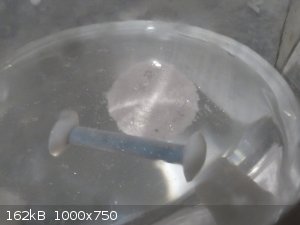
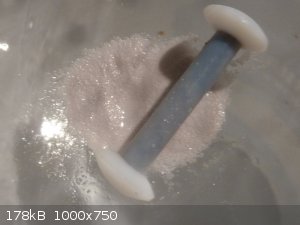 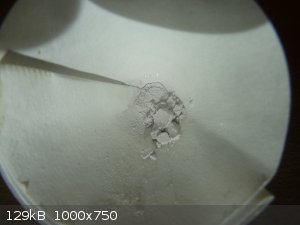 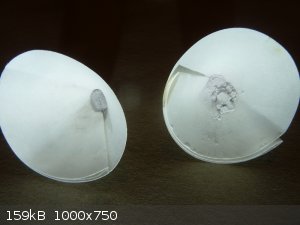
|
|
|
Nemo_Tenetur
Harmless

Posts: 28
Registered: 13-12-2023
Location: Germany
Member Is Offline
|
|
Second batch IS better
The trick is to use lower reaction temperature, prolonged reaction time and more diluted reagents.
The yield is also better, about 1310 mg from 1510 mg silver nitrate (approx. 98 % of theory).
The ignitability is much better, first attempt ignition delay 0,5 - 0,6 s, second attempt about 0,3 s (slow-motion 8 x). I think that´s okay, silver
azide explodes beyond 300 degree centigrade.
The second explosion was powerful enough to break a small red plastic piece out of the knife handle.
Attachment: Silver azide improved 1st flame test.mp4 (286kB)
This file has been downloaded 50 times
Attachment: Silver azide improved 1st flame test slow-motion.mp4 (336kB)
This file has been downloaded 42 times
Attachment: Silver azide improved 2nd flame test.mp4 (386kB)
This file has been downloaded 47 times
Attachment: Silver azide improved 2nd flame test slow-motion.mp4 (605kB)
This file has been downloaded 45 times 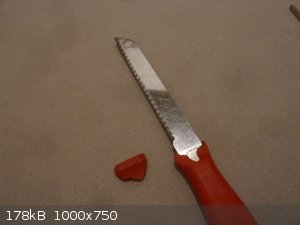
|
|
|
Etanol
Hazard to Others
  
Posts: 136
Registered: 27-2-2012
Member Is Offline
Mood: No Mood
|
|
The yield should always be quantitative. Most likely you have not neutralized the entire ammonia in first experiment.
[Edited on 13-2-2024 by Etanol]
|
|
|
Nemo_Tenetur
Harmless

Posts: 28
Registered: 13-12-2023
Location: Germany
Member Is Offline
|
|
Well, that´s possible. It is also possible that my cheap scale from ebay is not precise enough to weigh out such small quantities accurate. A third
option is that my filter paper was too coarse to retain 100 % of the precipitate.
And, by the way, even the patent does not claim 100% yield ...
[Edited on 13-2-2024 by Nemo_Tenetur]
[Edited on 14-2-2024 by Nemo_Tenetur]
|
|
|
pjig
Hazard to Others
  
Posts: 138
Registered: 25-5-2010
Member Is Offline
Mood: always learning
|
|
Nemo ….quote;
“Now the filter papers (washed first with distilled water, then with IPA) must dry completely before I can perform further tests.”
If I’m not mistaken, there’s a incompatibility with the isopropyl and silver salts, Not sure if it’s just silver nitrate, but the finished agn3
may The adversely affected.
Couple questions on my end. Always found that dextrinated material to be pretty workable ,and cool conditions on manufacture helped crystalline
structure.
Couldn’t a high %NC lacquer be used to bind the Agn3 to max the density and desensitize it to static, manipulation etc….. or could it have a
different effect , if riced to a granular state and packed into capsule , upon pressing the nc binder causing crystal matrix to internally sheer
causing a det? Guess one approach would be to put moist material in cap, and let dry w/o ricing and packing.
The only reason I inquire is I have seen NAP done this way, but not sure how to sensitivities of azides.
[Edited on 29-3-2024 by pjig]
|
|
|
Nemo_Tenetur
Harmless

Posts: 28
Registered: 13-12-2023
Location: Germany
Member Is Offline
|
|
Hi pjig,
I´ve observed the poor ignitability only with my first batch. Maybe the concentration or reaction time was too high. I´ve always performed the final
wash with IPA to speed up drying.
I know that dextrin is used in lead azide production to improve / reduce crystal size and shape (avoid long needles), but I´ve never heard this with
silver azide. I think quite the opposite is desired, a coarser grain size to improve density and flowability. Even without dextrin you get an
amorphous precipitate with low density and poor flowability. So why should dextrin be useful? Further particle size reduction?
Concerning NC laquer, I have no personal experience with this. But electrostatic discharge is really a serious matter with silver azide. The
sensitivity to impact and friction is - according to several published papers - even somewhat higher than lead azide.
I´ve synthesized only a few gram, stored in batches below one gram and separated from each other to minimize the risk and damage. Remote handling
with long clamps, thick leather or kevlar gloves and a face shield or at least safety goggles are strongly recommended. ESD is an evil!
Nickel aminoguanidine perchlorate is another topic. From what I´ve read here and within the patent, it´s ignition capability even surpasses lead
azide. The patent say that three milligram NAP enclosed in a glass capillary initiate PETN, whereas about 20 milligram lead azide are required. This
complex salt is definitely on my to-do-list next time.
If sensitivity is a decisive criterion for you, I would recommend NHN. It´s relatively safe to handle, but you require a much larger quantity and
confinement for a reliable DDT. You also require hydrazine hydrate, which is carcinogenic and really not OTC available.
|
|
|
pjig
Hazard to Others
  
Posts: 138
Registered: 25-5-2010
Member Is Offline
Mood: always learning
|
|
I believe NAP is less in initiation power, vs azide. Dextrin is important for Agn3 as is pbn3. Phlegmatizes the primary to reduce its static issue,
and the friction issue. Cold temp in the preparation is important for a small particle size , flatulent material . In this form it packs in caps very
well . Large crystals are not good in azides as your aware.
More my curiosity lies in a safe energetic primary, high density, highly ignitable , static free material . W/o large crystal structure.
|
|
|
underground
National Hazard
   
Posts: 697
Registered: 10-10-2013
Location: Europe
Member Is Offline
|
|
In my humble opinion NiCP is even better than NAP. Also Zink Carbohydrazide Perc is used commercially as inviromental friendly ad not toxic primary.
ZCP could be even better than NiCP due to Ni toxicity
Edit: I really dont know why there is so much focus on primaries while there are already a lot of options. I see no interesting for new secondaries
[Edited on 30-3-2024 by underground]
|
|
|
dettoo456
Hazard to Others
  
Posts: 178
Registered: 12-9-2021
Member Is Offline
|
|
Secondaries are interesting but they’re simply restricted by price. Sure, something like TKX-50 is cool, but it’s far too expensive $/g to ever be
worth making a useful amount of. Even RDX is way too cost prohibitive for amateurs. ETN and other nitrate esters or AN-based comps are the only real
obtainable materials. I’d say NQ is about where the line is in terms of affordability ($35/kg) for most interested parties.
|
|
|
underground
National Hazard
   
Posts: 697
Registered: 10-10-2013
Location: Europe
Member Is Offline
|
|
I mean, interesting for some cheap amateur friendly secondaries. Hexamine diperchlorate is one that comes into my mind. Guanidine perchlorate too.
Cocrystalized mixtues of easy to make HE or energetic fuels and oxidizers like AP and nitrogen rich fuels. Also there are a few secondaries that can
be made cheaply. NTO is one that comes into my mind. There are too plenty of options
[Edited on 30-3-2024 by underground]
|
|
|
dettoo456
Hazard to Others
  
Posts: 178
Registered: 12-9-2021
Member Is Offline
|
|
I might be in the minority then, as I just look for whatever is cheapest and stores best with favorable performance, though I do think some
‘exotics’ like the co-crystals you spoke of and maybe Boron based materials could be interesting. Also core-shell based materials are rarely
spoken of, when they could be very promising. Melamine encapsulated liquid/gel EMs seem attainable. Especially when a simple yet powerful EM like
Hydrazine Nitrate could be utilized.
Also, though given a bad rap, I think certain peroxides, like TMDD, deserve more research as potential oxidizers to replace AN or AP (partially). I
just don’t know how reactive it’d be in storage or mixed with materials prone to hydrolysis.
I wouldn’t say that something like NTO is cheap though, Semicarbazide in itself is a pain to prepare or buy.
|
|
|
pjig
Hazard to Others
  
Posts: 138
Registered: 25-5-2010
Member Is Offline
Mood: always learning
|
|
Peroxide is a very effective material . Moody as hell, and always seemingly trying to disassociate decompose its self. Axe shared some cool Gels with
it. But as a primary it’s most obtainable and simple to make. Back inthe day i flirted with hmtd it was an effective primary. But once bitten twice
shy. In a venture to explore density and power , I bound some with nc laq from hot shotgun powder . It was ona bbq skewer dried ina blob pea sized.
Retardedly I touched it off with a small torch. Well I’m sure you can imagine the shit eating look on my face when it went high order and turned the
skewer into a peeled flower shape. The torch was blown out of my hand and the hand holding the skewer felt like it was just bitch slapped for steeling
cookies. Nc bound materials are no joke.
I gladly steered away from these primaries
Earned much respect that day.
[Edited on 31-3-2024 by pjig]
|
|
|
Nemo_Tenetur
Harmless

Posts: 28
Registered: 13-12-2023
Location: Germany
Member Is Offline
|
|
Quote: Originally posted by underground  | I mean, interesting for some cheap amateur friendly secondaries. Hexamine diperchlorate is one that comes into my mind. Guanidine perchlorate too.
Cocrystalized mixtues of easy to make HE or energetic fuels and oxidizers like AP and nitrogen rich fuels. Also there are a few secondaries that can
be made cheaply. NTO is one that comes into my mind. There are too plenty of options
[Edited on 30-3-2024 by underground] |
Hmmm, are perchlorates really amateur friendly? Sodium and potassium perchlorate is regulated and highly restricted in the EU, ammonium perchlorate is
classified itself as high explosive, at least here in Germany.
Perchloric acid itself is not restricted, but really expensive. I´ve bought a liter for 110 euro, ouch.
So ammonium nitrate fertilizer (the standard 27 % nitrogen grade) is the only affordable source IMHO. Less than one euro per kilogramm, the 20 percent
crap (limestone) is easily removed. Although also regulated in the EU, due to the huge quantities marketed in the EU it´s not too hard to get a bag
branched off which last for a long time.
|
|
|
underground
National Hazard
   
Posts: 697
Registered: 10-10-2013
Location: Europe
Member Is Offline
|
|
Quote: Originally posted by Nemo_Tenetur  | Quote: Originally posted by underground  | I mean, interesting for some cheap amateur friendly secondaries. Hexamine diperchlorate is one that comes into my mind. Guanidine perchlorate too.
Cocrystalized mixtues of easy to make HE or energetic fuels and oxidizers like AP and nitrogen rich fuels. Also there are a few secondaries that can
be made cheaply. NTO is one that comes into my mind. There are too plenty of options
[Edited on 30-3-2024 by underground] |
Hmmm, are perchlorates really amateur friendly? Sodium and potassium perchlorate is regulated and highly restricted in the EU, ammonium perchlorate is
classified itself as high explosive, at least here in Germany.
Perchloric acid itself is not restricted, but really expensive. I´ve bought a liter for 110 euro, ouch.
So ammonium nitrate fertilizer (the standard 27 % nitrogen grade) is the only affordable source IMHO. Less than one euro per kilogramm, the 20 percent
crap (limestone) is easily removed. Although also regulated in the EU, due to the huge quantities marketed in the EU it´s not too hard to get a bag
branched off which last for a long time. |
It is not that hard to make perchlorates at all. Use an MMO for chlorides to chlorates and platinum bar for chlorates to perchlorates. I have made
killos of kclo4 with this way with very little wear of pt bar.
[Edited on 1-4-2024 by underground]
|
|
|
Sir_Gawain
Hazard to Others
  
Posts: 271
Registered: 12-10-2022
Location: Due South of Due West
Member Is Offline
Mood: Yes.
|
|
And that “platinum bar” cost how much?
“Alchemy is trying to turn things yellow; chemistry is trying to avoid things turning yellow.” -Tom deP.
|
|
|
dettoo456
Hazard to Others
  
Posts: 178
Registered: 12-9-2021
Member Is Offline
|
|
Pt or MMO electrodes aren’t absurdly expensive but they do pose a higher cost to entry for obtaining Chlorates & Perchlorates than just buying
the salts directly.
I’m surprised NH4NO3 is still available in Eur even, it’s very annoying to get ahold of at a decent price in the US, unless you have a farm &
business license. And I’d rather have access to cheap AN than Perchlorates.
This whole discussion has ventured off topic though.
[Edited on 1-4-2024 by dettoo456]
|
|
|
underground
National Hazard
   
Posts: 697
Registered: 10-10-2013
Location: Europe
Member Is Offline
|
|
I guess it depends from country to country. You can google it. It may cost a bit but you will buy it once or twice ( if you want more surface area)
and probably it will last a lifetime. Pt bar is not like pt anode. It is much better.
[Edited on 2-4-2024 by underground]
|
|
|
| Pages:
1
..
16
17
18 |